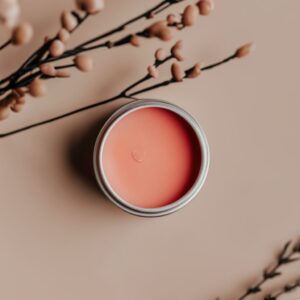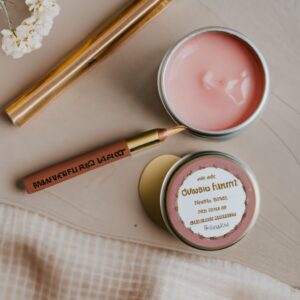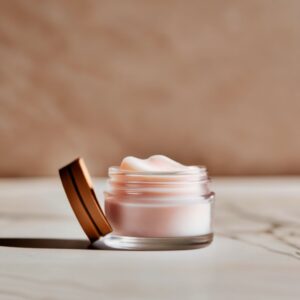
Welcome to the world of vegan lip care! If you’re passionate about cruelty-free beauty and sustainability, you’ve come to the right place. In this guide, we’ll explore how to create your own vegan lip balm using simple, natural ingredients. From DIY vegan lip balm recipes to tips on using carnauba wax and candelilla wax, we’ve got everything you need to make your lips feel nourished and fabulous, without harming any animals. Let’s dive in and discover how to make your own vegan lip balm and lip gloss from the comfort of your own home!
why sholud you use vegan lip balm
- Cruelty-free: Vegan lip balm avoids animal testing and ingredients derived from animals, promoting ethical beauty practices.
- Plant-powered: Crafted with natural plant-based ingredients like candelilla wax and botanical oils, vegan lip balms offer nourishment and protection for your lips.
- Environmentally friendly: By opting for vegan lip balm, you contribute to reducing the demand for animal products and support sustainable beauty choices.
- Clean and safe: Vegan formulas typically exclude harsh chemicals, synthetic fragrances, and additives, offering a safer and healthier option for lip care.
- DIY versatility: With various DIY vegan lip balm recipes available, you can experiment with different ingredients and create customized lip products tailored to your preferences.
vegan lip balm recipe

how to make vegan lip balm
Ingredients:
- 2 tablespoons candelilla wax
- 2 tablespoons coconut oil
- 2 tablespoons shea butter
- 1 tablespoon sweet almond oil
- Optional: 5-10 drops of essential oil for fragrance (e.g., peppermint, lavender)
Instructions:
- In a double boiler or microwave-safe bowl, melt the candelilla wax, coconut oil, and shea butter together until fully liquefied.
- Remove from heat and stir in the sweet almond oil.
- If desired, add a few drops of your chosen essential oil for fragrance and additional benefits. Stir well to combine.
- Carefully pour the melted mixture into lip balm containers or small jars. Leave some space at the top to avoid spillage when solidifying.
- Allow the lip balm to cool and solidify at room temperature for several hours or place it in the refrigerator for faster results.
- Once solidified, cap the containers and store your homemade vegan lip balm in a cool, dry place.
- Apply to lips as needed for hydration and protection.
Enjoy your nourishing and cruelty-free DIY vegan lip balm!
Customization Ideas for Vegan Lip Balm
| Customization Ideas for DIY Vegan Lip Balm | Customization Tips |
|---|---|
| 1. Experiment with Different Essential Oils | Try adding lavender, peppermint, or citrus essential oils for various scents and additional benefits like relaxation or invigoration. |
| 2. Add Natural Colorants | Consider incorporating natural colorants like beetroot powder, cocoa powder, or alkanet root powder to give your lip balm a hint of color without artificial dyes. |
| 3. Infuse with Herbs or Botanicals | Infuse your lip balm with dried herbs or botanicals like calendula, chamomile, or rose petals for added nourishment and a touch of natural fragrance. |
| 4. Adjust Texture with Different Waxes | Experiment with different plant-based waxes such as candelilla wax, soy wax, or carnauba wax to achieve your desired lip balm texture, from soft and creamy to firm and long-lasting. |
| 5. Incorporate Nutrient-Rich Oils | Enhance the moisturizing properties of your lip balm by adding nutrient-rich oils like jojoba oil, avocado oil, or almond oil, each offering unique benefits for your lips. |
| 6. Include Healing Butters | Boost the healing properties of your lip balm by including nourishing butters such as shea butter, cocoa butter, or mango butter, known for their ability to soothe and repair dry, chapped lips. |
| 7. Personalize Packaging | Get creative with the packaging by using reusable tins, eco-friendly tubes, or small glass jars, and add your own labels or decorations to make your lip balm uniquely yours. |
| 8. Experiment with Sweeteners | Add a hint of sweetness to your lip balm by incorporating natural sweeteners like agave nectar, honey (if not strictly vegan), or stevia extract, balancing flavor with nourishment. |
| 9. Consider SPF Protection | To provide additional protection from the sun’s harmful rays, consider adding natural SPF ingredients like raspberry seed oil or carrot seed oil to your lip balm formula. |
| 10. Test Different Consistencies | Play around with the ratio of oils, waxes, and butters to achieve your preferred lip balm consistency, whether you prefer a glossy finish, a matte look, or something in between. |
tips for vegan lip balm

By following these tips, you can create a luxurious and nourishing vegan lip balm that keeps your lips soft, smooth, and protected. Enjoy the process of making your own beauty products and embracing a cruelty-free lifestyle!
- Choose High-Quality Ingredients: Opt for organic and sustainably sourced ingredients whenever possible to ensure the best results for your lip balm.
- Adjust Consistency: If you prefer a softer lip balm, you can increase the amount of coconut oil or sweet almond oil in the recipe. For a firmer texture, use more candelilla wax.
- Customize with Essential Oils: Experiment with different essential oils to create unique scents and add additional benefits. Just make sure to use skin-safe essential oils and test for sensitivity before applying to your lips.
- Be Patient During Cooling: Allow the lip balm mixture to cool and solidify completely before using or capping the containers. Rushing this process may result in uneven texture or premature melting.
- Use Clean Containers: Ensure that the lip balm containers or jars you use are clean and sterilized before pouring in the melted mixture to prevent contamination.
- Store Properly: To prolong the shelf life of your DIY vegan lip balm, store it in a cool, dry place away from direct sunlight. This will help prevent the oils and butters from going rancid.
- Share the Love: Consider making extra batches of lip balm to share with friends and family. Homemade lip balm makes a thoughtful and eco-friendly gift for any occasion.
Benefits of Vegan Lip Balm:

By incorporating DIY vegan lip balm into your beauty routine, you can enjoy all these benefits while promoting ethical and sustainable beauty practices.
- Cruelty-Free: Vegan lip balms do not contain any animal-derived ingredients, making them a compassionate choice for those who prefer cruelty-free beauty products.
- Natural Ingredients: By using plant-based ingredients like candelilla wax, coconut oil, and shea butter, vegan lip balms offer a natural alternative to conventional lip care products.
- Moisturizing: The rich blend of nourishing oils and butters in vegan lip balm helps to hydrate and moisturize dry, chapped lips, leaving them feeling soft and smooth.
- Customizable: DIY vegan lip balm recipes allow you to customize the ingredients and scents to suit your preferences. You can experiment with different oils, butters, and essential oils to create a lip balm that works best for you.
- Gentle and Non-Irritating: Vegan lip balms are often formulated without harsh chemicals or artificial fragrances, making them suitable for sensitive skin types.
- Environmental-Friendly: By opting for vegan lip balm, you’re supporting sustainable and eco-friendly practices that minimize harm to animals and the environment.
- Affordable: Making your own vegan lip balm at home can be cost-effective compared to purchasing store-bought options, especially if you already have some of the ingredients on hand.
- Fun DIY Project: Creating your own vegan lip balm can be a fun and rewarding DIY project. It allows you to get creative in the kitchen while also knowing exactly what ingredients are going into the products you use on your lips.
FAQ’S
- What makes lip balm vegan? Lip balm is considered vegan when it doesn’t contain any animal-derived ingredients. This includes substances like beeswax, lanolin, or carmine, which are commonly found in non-vegan lip balms.
- What ingredient should not be in lip balm? Lanolin, a substance extracted from sheep’s wool, is an ingredient that should be avoided in vegan lip balms. Other non-vegan ingredients include beeswax, carmine (a red pigment derived from insects), and certain types of animal-derived oils.
- How do you make waxless lip balm? Waxless lip balms can be made using a combination of plant-based butters, oils, and thickeners like shea butter, coconut oil, cocoa butter, and carnauba wax or candelilla wax alternatives to achieve the desired consistency without traditional waxes.
- What is a good substitute for beeswax in lip balm? Candelilla wax or carnauba wax are excellent alternatives to beeswax in lip balm recipes. These plant-based waxes offer similar binding properties and create a smooth texture without compromising on the quality of the product.
- How do you make vegan lip balm without beeswax? Vegan lip balm recipes without beeswax typically use plant-based alternatives like candelilla wax, carnauba wax, or soy wax combined with nourishing oils, butters, and essential oils to create a hydrating and soothing balm.
- What oil is best for lip balm? Some of the best oils for lip balm include coconut oil, almond oil, jojoba oil, avocado oil, and cocoa butter. These oils are hydrating, nourishing, and easily absorbed by the delicate skin of the lips.
- What is a substitute for beeswax? Plant-based waxes like candelilla wax, carnauba wax, soy wax, or even vegetable shortening can be used as substitutes for beeswax in lip balm recipes, providing similar binding and moisturizing properties.
- What is a substitute for shea butter in lip balm? Cocoa butter, mango butter, or avocado butter can be used as substitutes for shea butter in lip balm recipes. These plant-based butters offer similar moisturizing benefits and can be used interchangeably in most formulations.
- Can I use Vaseline instead of beeswax? Vaseline, or petroleum jelly, can be used as an alternative to beeswax in lip balm recipes, although it creates a different texture and consistency. It’s important to note that Vaseline is not vegan as it’s derived from petroleum.
- Can I use coconut oil instead of beeswax? Coconut oil can be used in combination with other ingredients as a substitute for beeswax in lip balm recipes to provide hydration and nourishment. However, it alone may not offer the same binding properties as beeswax.
- Is candelilla wax harder than beeswax? Candelilla wax is generally harder and has a higher melting point than beeswax, making it an excellent choice for formulations where a firmer texture is desired. It provides a smooth, glossy finish and helps create a protective barrier on the lips.
